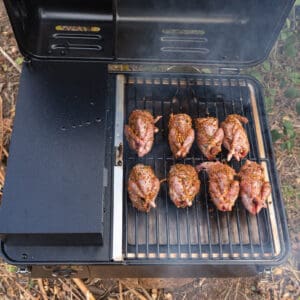Home » Small Game Cooking » How to Make Smoked Quail on a Pellet Grill
How to Make Smoked Quail on a Pellet Grill

Jack Hennessy grew up in the South Suburbs of Chicago…
Discover the art of smoking quail to juicy perfection with our easy-to-follow pellet grill recipe. Impress with every tender bite!
Two culinary extremes exist when properly cooking quail meat: hot and fast or very low and slow. Pellet grills are perfect for the latter method. Not only are pellet grills great at maintaining the low temps needed to heat quail evenly, but their smoky flavor tastes second to none on upland birds.
With this one, I ran Traeger’s Ranger with their cherry wood offering. You can change the pellets to fit your favorite smoky-flavor profile.
There’s one major difference between a hot-and-fast roast versus a slow-and-low smoke. When cooking with high temps, the bird’s skin should be dry so it can crisp up. When smoking meat at low temps, you actually want the bird to be a bit moist and cold when it hits the pellet grill.
Why? Science. Specifically, thermophoresis. This force is observed when suspended particles move from higher temperatures toward lower temperatures when exposed to a temperature gradient. In simpler terms, it is the process of hot smoke being attracted to cold meat.
Inside your smoker, a very thin layer of stagnant air surrounds the meat, which serves as a barrier for smoke particles. However, when water molecules evaporate from the surface of the meat, this creates an outward flow of molecules that break up the stagnant air boundary around the meat. These evaporating molecules also create a counterflow of heavy smoke particles back to the surface of the comparatively cooler meat. This is thermophoresis at work.
The longer the meat creates evaporating moisture, the longer the smoke will adhere. For this reason, sometimes, it’s advised to put partially frozen meat on smokers to extend thermophoresis. This act of science is the reason many pitmasters frequently spritz their smoking meat with various liquids.
But towards the end of the smoke on these smaller birds, their surface area won’t be cold and wet, so we then incorporate a bit of maple syrup so the smoke can continue to stick.
Add Traeger’s Fin & Feather spice rub, you’ll taste an incredibly balanced array of savory flavors, fresh herbs, and sweet notes. Add in a little maple syrup; trust me, you’ll want to eat these as fresh off the grill as possible. Picking off every last mapley morsel is truly enjoyable and unforgettable the first time you taste it.
You can apply these methods and logic to any upland bird. Just remember that your cooking times will vary based on the size of bird (cook larger birds for longer).

Smoked Quail Recipe: Pellet Grill Perfection
Equipment
- 1 Pellet grill
Ingredients
- 8 whole quail plucked and trussed
- Traeger Fin & Feather spice rub or your own favorite spice rub
- Cooking-oil spray
- Maple syrup
Instructions
- Before you spice the quail, truss the birds with kitchen twine (tie the legs close to the body). After doing so, liberally spice all sides of each bird and place them in the fridge until you’re ready to smoke.
- Set the pellet grill to 160 F and full smoke. Smoke the quail for 1 hour, breast-side up, at 160 F.
- Turn the pellet grill up to 225 F and spray all sides of the quail with the cooking oil. Flip the quail, turning them breast-side down. Smoke the quail for an additional 30 minutes. This will help create crispy skin.
- Lastly, turn the pellet grill back down to 160 F and turn the birds breast-side up. Keep the top of the grill up to allow the temperature to reduce quickly. For the next half hour, lightly glaze the birds with maple syrup every 10 minutes.
- After that final half-hour at 160, your quail should be perfect. The birds will have crispy skin with a nice sweet and savory flavor. Eat them fresh off the grill; no need to allow them to cool. You’ll find that they’re tastier than Grandma’s freshly baked chocolate chip cookies.
Jack Hennessy grew up in the South Suburbs of Chicago and didn't start hunting until he attended graduate school in Spokane, Washington, at the age of 26. Hennessy began work in professional kitchens in high school but didn't start writing wild game recipes until he joined the Spokesman-Review in 2014. Since then, his recipes have appeared with Petersen's Hunting, Backcountry Journal, Gun Dog Magazine, among many others. He now lives with his Wirehaired Vizsla, Dudley, in Wichita, Kansas.





On step 3 how long do you leave the quail @225 breast side down?
Half hour. I will get that edit in. Thanks for catching that.